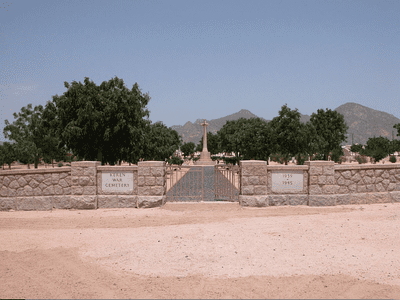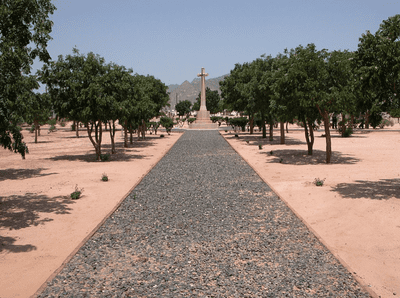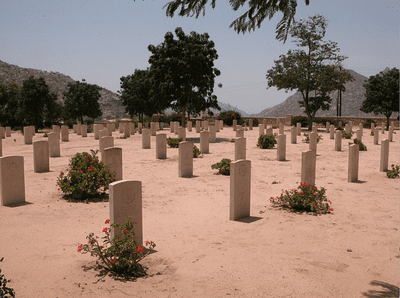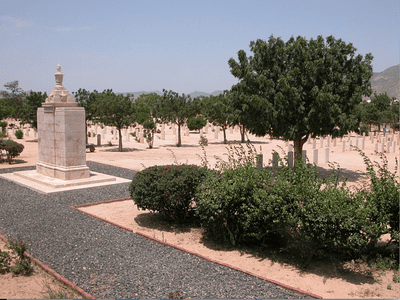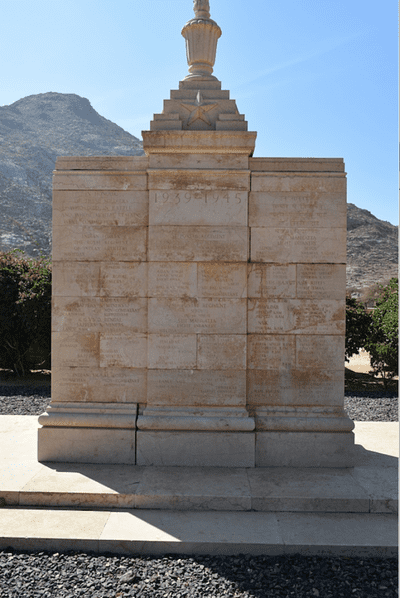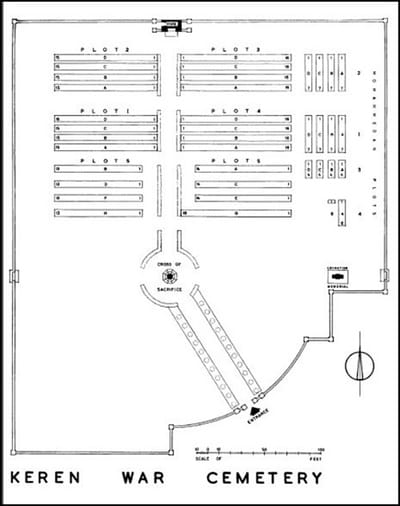KEREN WAR CEMETERY AND CREMATION MEMORIAL
Keren
Eritrea
Location Information
The small town of Keren is about 90 kilometres west of Asmara.
Keren War Cemetery is 2 kilometres west of the town. The site, on top of the famous Keren pass and overshadowed by Cameron's Ridge on the opposite side of the road, was presented by the Chief and the Community of Ad Hadembas, and an inscription recording this has been built into the cemetery wall.
Visiting Information
Keren War Cemetery is open Monday to Friday between 06:00 and 18:00. Wheelchair access to the cemetery is possible via main entrance, however assistance will be necessary due to gravel paths and sand inside the cemetery. For further information regarding wheelchair access, please contact our Enquiries Section on 01628 507200.
Visitors arriving in Asmara are advised that an official travel permit is required before attempting to travel to Keren. This can be obtained from the Min. of Tourism Information Office, next to St Mary’s Cathedral. If intending to also visit the battlefield, which lies just 1km to the south west of Keren War Cemetery, a second travel permit is required for Tinquilahas.
These travel permits should be applied for at the same time, before leaving Asmara. The process generally takes a day. It is not possible to obtain a travel permit to visit the Tinquilahas battlefield once in Keren.
Historical Information
Keren was the last Italian stronghold in Eritrea and the scene of the most decisive battle of the war in East Africa in February and March 1941.
Guarding the entrance from the western plains to the Eritrean plateau, the only road passing through a deep gorge with precipitous and well fortified mountains on either side, Keren formed a perfect defensive position. On these heights the Italians concentrated some 23,000 riflemen, together with a large number of well sited guns and mortars. A preliminary assault by United Kingdom and Indian troops was repulsed after a week of bitter fighting, although they gained and held a valuable position on Cameron's Ridge, on the left of the road.
The final battle began a month later. After ten days of gruelling combat the Commonwealth troops succeeded in forcing their way through the seemingly impregnable defences on the ridge and finally through the 200 metre long road block which the Italians had blasted at the narrowest point in the pass. Keren was taken on 27 March. The defeated Italian force retreated in some disarray to Asmara, which fell to Commonwealth forces on 1 April, and the Italian surrender was taken at the port of Massawa on 8 April.
KEREN WAR CEMETERY contains 440 Commonwealth burials of the Second World War, 35 of them unidentified.
The KEREN CREMATION MEMORIAL stands within the cemetery and commemorates 285 Sikh and Hindu soldiers from India and Pakistan killed on the Keren battlefield during the Second World War, whose remains were cremated in accordance with their faith. Three East African soldiers are also commemorated on the memorial.
The small town of Keren is about 90 kilometres west of Asmara.
Keren War Cemetery is 2 kilometres west of the town. The site, on top of the famous Keren pass and overshadowed by Cameron's Ridge on the opposite side of the road, was presented by the Chief and the Community of Ad Hadembas, and an inscription recording this has been built into the cemetery wall.
Visiting Information
Keren War Cemetery is open Monday to Friday between 06:00 and 18:00. Wheelchair access to the cemetery is possible via main entrance, however assistance will be necessary due to gravel paths and sand inside the cemetery. For further information regarding wheelchair access, please contact our Enquiries Section on 01628 507200.
Visitors arriving in Asmara are advised that an official travel permit is required before attempting to travel to Keren. This can be obtained from the Min. of Tourism Information Office, next to St Mary’s Cathedral. If intending to also visit the battlefield, which lies just 1km to the south west of Keren War Cemetery, a second travel permit is required for Tinquilahas.
These travel permits should be applied for at the same time, before leaving Asmara. The process generally takes a day. It is not possible to obtain a travel permit to visit the Tinquilahas battlefield once in Keren.
Historical Information
Keren was the last Italian stronghold in Eritrea and the scene of the most decisive battle of the war in East Africa in February and March 1941.
Guarding the entrance from the western plains to the Eritrean plateau, the only road passing through a deep gorge with precipitous and well fortified mountains on either side, Keren formed a perfect defensive position. On these heights the Italians concentrated some 23,000 riflemen, together with a large number of well sited guns and mortars. A preliminary assault by United Kingdom and Indian troops was repulsed after a week of bitter fighting, although they gained and held a valuable position on Cameron's Ridge, on the left of the road.
The final battle began a month later. After ten days of gruelling combat the Commonwealth troops succeeded in forcing their way through the seemingly impregnable defences on the ridge and finally through the 200 metre long road block which the Italians had blasted at the narrowest point in the pass. Keren was taken on 27 March. The defeated Italian force retreated in some disarray to Asmara, which fell to Commonwealth forces on 1 April, and the Italian surrender was taken at the port of Massawa on 8 April.
KEREN WAR CEMETERY contains 440 Commonwealth burials of the Second World War, 35 of them unidentified.
The KEREN CREMATION MEMORIAL stands within the cemetery and commemorates 285 Sikh and Hindu soldiers from India and Pakistan killed on the Keren battlefield during the Second World War, whose remains were cremated in accordance with their faith. Three East African soldiers are also commemorated on the memorial.
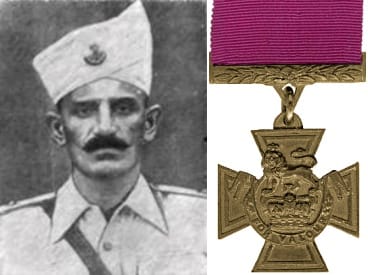
7055/IO Subador Richhpal Ram, V. C.
4th Bn. 6th Rajputana Rifles, died 12th February 1941 aged 42. Column 5
Son of Mohar Singh; husband of Janki, of Barda, Patiala, India.
(Commemorated on the Cremation Memorial)
Citation: The following details are given in the London Gazette of July 1st, 1941:-On the night of February 7th-8th, 1941 Subadar Richhpal Ram was second in command of a leading company attacking enemy positions in front of Keren Eritrea. With great dash and gallantry he led the forward platoon to the first objective, and when his company commander was wounded assumed command of the company. He then led the remaining two platoons in an attack which captured the final objective in the face of heavy fire. The party, completely isolated, under the inspiring leadership of Subadar Richhpal Ram beat back six enemy counter-attacks between midnight and 0430 hours, when ammunition ran out. This officer then extricated his command fighting his way back to the battalion. On February 12th, leading another attack, he pressed on fearlessly under heavy and accurate fire, inspiring his company by his example, until his right foot was blown off. He suffered further wounds from which he died. The heroism, determination, and devotion to duty shown by this officer were beyond praise, and an inspiration to all who saw him.
4th Bn. 6th Rajputana Rifles, died 12th February 1941 aged 42. Column 5
Son of Mohar Singh; husband of Janki, of Barda, Patiala, India.
(Commemorated on the Cremation Memorial)
Citation: The following details are given in the London Gazette of July 1st, 1941:-On the night of February 7th-8th, 1941 Subadar Richhpal Ram was second in command of a leading company attacking enemy positions in front of Keren Eritrea. With great dash and gallantry he led the forward platoon to the first objective, and when his company commander was wounded assumed command of the company. He then led the remaining two platoons in an attack which captured the final objective in the face of heavy fire. The party, completely isolated, under the inspiring leadership of Subadar Richhpal Ram beat back six enemy counter-attacks between midnight and 0430 hours, when ammunition ran out. This officer then extricated his command fighting his way back to the battalion. On February 12th, leading another attack, he pressed on fearlessly under heavy and accurate fire, inspiring his company by his example, until his right foot was blown off. He suffered further wounds from which he died. The heroism, determination, and devotion to duty shown by this officer were beyond praise, and an inspiration to all who saw him.

